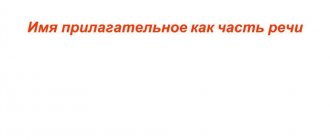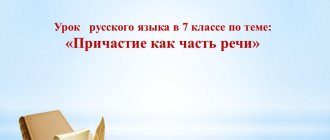Lesson “Plug-in words, phrases and sentences”, 8th grade
Municipal educational institution
secondary school No. 2 in Kondopoga
A Russian language lesson in 8th grade was prepared by a Russian language teacher
Pochebyt Tatyana Evgenievna
Topic: “Insert words, phrases
,
suggestions"
Educational goals of the lesson
:
- To develop the skill of recognizing inserted structures and highlighting them in writing with punctuation marks;
- Develop the ability to detect introductory and inserted structures in the text, determine their purpose; use introductory words and plug-in constructions as a means of connecting sentences in the text, prepare students for public speaking on a socially significant topic;
- To cultivate a sense of beauty, introducing students to Russian folk songs, and to cultivate a culture of speech.
Form UUD:
regulatory: determine the purpose of the educational activity, evaluate the results of collective activity, analyze your own work, plan your actions in accordance with the task, determine the goal of the educational activity (stage) in collaboration with a friend and teacher; distinguish between the main and secondary actions in the process.
communicative: listen to your interlocutor, listen to a monologue on a linguistic topic, formulate questions, express your own opinion, be able to conduct a dialogue to organize all activities;
cognitive: systematize the material obtained in previous lessons, extract the necessary information from different sources of information, work with tasks of different levels, follow the rules of pronunciation and spelling.
Planned result
:
Subject UUD:
- Know the concepts of introductory words, sentences, plug-in constructions, distinguish between them,
- construct sentences with introductory words, plug-in constructions,
- compose a coherent text using introductory words and inserted structures on a socially significant topic.
Personal UUD:
- Be able to conduct self-assessment based on the criterion of success of educational activities, motivation of educational activities.
Metasubject UUD:
- Be able to evaluate the results of collective activities, analyze your own work, plan your actions in accordance with the task.
- Be able to determine the purpose of educational activities, listen to the interlocutor, materials, and formulate your own opinion and position.
- Be able to express your thoughts with accuracy and sufficient completeness.
- Be able to systematize the material obtained in previous lessons, navigate the textbook, find the necessary information, working with different sources of information, with tasks of different levels, be able to create algorithms for solving a problem.
Lesson type
: combined
Methods
: verbal-illustrative, problem-search, analysis of situations in pairs and groups, group discussion.
Work organization
: in pairs, in groups (groups of “experts” and “students” are chosen at will during the lesson).
Equipment:
computer, interactive whiteboard, media projector, presentation “Plug-in words, phrases and sentences”, printed materials for practical work.
presentation for the lesson PPTX / 212.24 Kb
During the classes
I. Organizational stage.
Creating a positive attitude. Greetings.
- Hello guys. Today we will begin our lesson by turning to the statements of famous people, as well as to the folk wisdom contained in the proverb. (Slide 2)
1. Creativity is the beginning that gives a person immortality. (Romain Rolland).
2. Russian folk song is a most precious example of folk art. (P.I. Tchaikovsky)
3. With song the soul grows. (Russian proverb)
- What idea do you think unites all three statements? (Analysis of quotes, student output)
- How are the statements related to the topic of our lesson? (assumptions)
II . Updating knowledge.
1. To set a learning task, complete the following task in pairs (slide 3):
- Using introductory words or sentences, rearrange the sentences so that they contain an indication of the source of the message.
Options:
According to R. Rolland, creativity is the beginning that gives a person immortality.
According to P.I. Tchaikovsky, Russian folk song is the most precious example of folk art.
As the popular proverb says, the soul grows with song.
— What are the names of words and phrases that help indicate the source of a message? (introductory words and sentences)
- What is the connection with the topic of the lesson, the objectives of the lesson and these statements?
2. Setting a learning task (slide 4).
Announcement of the topic and goals of the lesson (slide 5). Recording the topic of the lesson in notebooks.
- So, these constructions can bring different shades of meaning to a sentence. To continue studying introductory constructions, we systematize the studied material by completing the task: we make notes in notebooks, the expert group formulates questions (optional choice, 5 - 7 people)
III . Systematization of the studied material. Watching a video
(slide 6)
WMV video file / 38.21 MB
I V .
Control of assimilation, discussion of opinions and their correction
. A working group of “experts” asks questions, corrects answers, and an individual survey is given in writing to a group of “students.”
Survey
(slide 7), in parallel with this - individual work third wheel DOC / 27.5 KB
- What is the difference between introductory words and introductory sentences?
- What role do plug-in structures play?
- What is the difference between introductory sentences and plug-in constructions?
- What punctuation marks are used to distinguish plug-in constructions? Give examples.
V. _ Fizminutka
physical training DOC / 26.5 Kb
VI . Practical work on the text ex. 325, p.213
(slide 
1.Read the text.
2. Determine the type of speech.
3.What problem is the author talking about? What does it call for?
4.Which sentence is an argument?
5.Which insertion structure enriches V. Kozhinov’s statement?
6.Explain the placement of punctuation marks in sentences with plug-in constructions.
Conclusions: Journalistic style text. V. Kozhinov speaks out in defense of folk song, calling it “a necessary phenomenon of the spiritual existence of Russia.” In the thesis, the author used two plug-in constructions. The first contains an explanation of the proximity of the words “spirituality” and “air” in relation to folk song, the second complements the sentence.
VII . Preparing for a public speaking.
1. An audio recording of the song “The Moon is Shining” performed by L.A. Ruslanova plays (slide 9)
2. Conversation based on the text (printouts on desks, slide 10)
texts about L. Ruslanova DOC / 33 Kb
1.Read the text expressively.
2. How does the author explain the popularity of songs performed by L. Ruslanova?
3.What plug-in structures does the author use?
4.Explain the placement of punctuation marks in sentences with plug-in constructions. Is it possible to use other symbols instead of brackets?
5. Based on the arguments given in the text, as well as on your own impressions, submit a song performed by L. Ruslanova to the competition.
6. Use introductory words and plug-in structures in your speech.
VIII . Reflection
(slide 11)
Questions:
- What was interesting in the lesson?
- What practical skills did you gain?
- What difficulty did you face?
- Do you understand your homework?
- What sources of information will help you better prepare for public speaking?
- What statement can be chosen as the epigraph of a speech?
IX . Homework
(slide 12
)
- Prepare a public speech, based on the arguments given in the text, as well as on your own impressions, for the competition “Song is the soul of the people” (exercise 386)
Sample plan:
1. Greeting the audience.
2. Presentation of the song and its artist.
Used sources:
Video tutorial “Plug-in structures” https://www.youtube.com/watch?v=7KBmrArnJaM
Song by L. Ruslanova https://basshunter.org/music-search/Lidiya_Ruslanova_-_shines_month_music01.html#play
Ruslanova L.
Fizminutka https://gymnasium406.ru/sites/default/files/images/pedagogam_i_uchaschimsya/fizkultminutka.pdf
Presentation background




